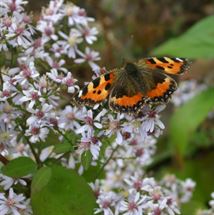
Butterflies and Moths (Lepidoptera)
-
The vast majority of Lepidoptera species in the UK are moths.
-
Butterflies are a numerically smaller group but better-known because they fly by day.
-
The larvae of butterflies and moths (caterpillars) feed on the leaves of a range of food plants
-
The adults ingest nectar, as a high-energy fuel for flight. They do not eat pollen.
 |
|
 |
|
.jpg) |
Adult butterflies and moths have a long, very thin feeding tube (proboscis) that is used to suck nectar by capillary action. You can clearly see this in the picture on the left. When not in use it is usually folded up like a coiled spring.
They take nectar from small tubular flowers, or flowers such as Hemp Agrimony (Eupatorium cannabinum), Wild Marjoram (Origanum vulgare) and Scabiouses, which consist of of small tubular florets bunched into larger inflorescences.
The nectaring habits of moths are less-well known than those of butterflies. As well as visiting specialist 'moth plants' (see my fact sheet) it is likely that they visit the nectar flowers that butterflies visit during the day.
Butterflies in particular are sensitive to cold wet weather and do not do well in bad summers. In gardens they prefer sheltered, sunny areas in which to feed on nectar.
Butterfly and moth caterpillars feed mainly on leaves, including a number of grasses. They often have very specific food plants, which are not necessarily of the same species as the flowers from which they take nectar.
Long-term trends in butterfly distribution and abundance in the UK are fairly well understood due to the recording and monitoring activity by members of the Butterfly Conservation organisation.
Those of us who were around in the 1960s, and 1970s have childhood memories of Buddleja bushes covered with butterflies, and a blizzard of moths at night in the car headlights. That's not so common nowadays. Things seemed to go downhill from the 1980s onwards. It is worth every effort to support and encourage moths and butterflies.
Remember that the presence of the specific caterpillar food plants really matters for breeding purposes. You can grow the food plants of many species of butterflies and moths in your garden. The adults on the other hand seem to take nectar from any suitable flowers that are adapted to provide nectar to butterflies and moths. There are many books about butterflies and moths and 'butterfly gardening'. most of them give details of the caterpillar food plants.
Download my pdf Factsheet about Flowers for Moths here.
For more info about butterflies and moths go to these pages:
Insects and Flowers explains how insects collect food from flowers.
Flower shapes explains how flowers appeal to different groups of insects.
Citizen Science explains that you can submit records on-line.
Recommended Reading contains a downloadable bibliography which has a page of suggested books about gardening for butterflies and moths, and their caterpillar food plants.
Last updated 9 October 2015. Copyright © Marc Carlton 2006 - 2015. See 'About this Website' for terms of use.


